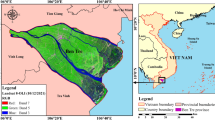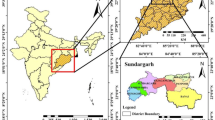Abstract
Mapping the distribution of land use provides critical information for sustainable management of vegetation resources. In the present study an attempt has been made to identify the land use/land cover categories with special reference to tea plantations in Barak Valley, Assam. Mapping has been carried out using IRS P6 AWiFS data. Unsupervised digital classification technique was used for identification of major land use/land cover. The total area of tea plantations was found to be 28,594.3 ha which represents 4.2 % of the total geographical area. The overall classification accuracy was found to be 92.27 %. The study reveals that the AWiFS data has proved to be successful in extracting information of various land use/land cover categories. The spatial data generated in the study provides a key input for strategic management of land use including tea plantations.



Similar content being viewed by others
References
Anderson JR, Hardy EE, Roach TJ, Whitmer RE (1976) A landuse landcover classification system for use with remote sensing data. US Geological Survey Professional Paper 964. U.S. Govt. Print Office: Washington DC
Champion HG, Seth SK (1968) A revised survey of the forest types of India. Manager of Publications, Government of India press, Nasik
Colwell RN (ed) (1960) Manual for photographic interpretation. The American Society of Photogrammetry, Washington, DC
Dutta R (2006) Assessment of tea bush health and yield using Geospatial techniques. Published M. Sc. Thesis, ITC. GIS development, The Geospatial Resource Portal, Enschede
Ghosh A, Roy A (2004) GIS Anchored integrated plantation management: tea. Map India 2004 Proceeding
Hegde VR, Jayaraj KR, Karale RL, Subbarao P (1994) Area estimation of arecanut plant in Sirsitaluka using IRS data. J Indian Soc Remote Sens 22(3):149–153
Jensen JR (2005) Introductory digital image processing: a remote sensing perspective, 3rd edn. Prentice Hall, Upper Saddle River
Kalra NK, Sankhla DS, Joshi FK, Parmar AK, Ghelot A, Purohit NL (2000) Soyabean acreage estimation in Chambal command area in Rajasthan using IRS 1 C data. NNRMS Bull 24:22
Kumar V, Rai SP, Rathore DS (2004) Land use mapping of Kandi belt of Jammu region. J Indian Soc Remote Sens 32(4):323–328
Lillesand TM, Kiefer RW (2000) Remote sensing and image interpretation, 4th edn. Willey, Chichester
Maruthachalam AR, Parihar JS, Sharma R, Oza SR (1993) Tea acreage estimation and condition assessment using satellite data in Nilgiri district, Tamil Naidu. J Indian Soc Remote Sens 21(4):199–207
Navalgund RR and Ray SS (2000) Geomatics in natural resource management. In proceeding Geomatics in natural resource management, NRI-NR14, Pune
Navalgund RR, Parihar JS, Ajai, Rao PPN (1991) Crop inventory using remote sensing data. Curr Sci 61(3):162–171
Pal DK, Joseph S, Sengupta S and Nair CKU (1993) Short-wave IR bands in moisture stress and garden condition assessment of tea estates in North-eastern India. Proceedings of national symposium on applications of resource management with special emphasis on NE region, pp 424–432
Pandey AC and Nathawat MS (2002) Land use-land cover mapping through digital image processing of satellite data—A case study from Panchkula, Ambala and Yamunanagar districts, Haryana State. MAP ASIA 2002 Proceeding, Bangkok, 7–9 August
Patnaik C, Chakraborty M and Ladsariya KR (1998) Satellite remote sensing based Mentha arvensis acreage estimation in U.P. Scientific Note SAC/RESA/SR/02/98. Space applications Centre, Ahmedabad
Rao NR, Kapoor M, Sharma N, Venkateswarlu K (2007) Yield prediction and waterlogging assessment for tea plantation land using satellite based techniques. Int J Remote Sens 8(7):1561–1576
Soares DM, Galvao LS, Formaggio AR (2008) Crop area estimation from original simulated spatial resolution data and landscape metrics. Scientia Agricola 65:459–467
Acknowledgments
Author thank to the University Grant Commission for financial assistance and the Tea Estate Managers for their kind co-operation and help during the ground truth data collection.
Author information
Authors and Affiliations
Corresponding author
Rights and permissions
About this article
Cite this article
Devi, N.P., Sudhakar Reddy, C., De, A. et al. Spatial Assessment of Land Use in Barak Valley, Assam Using Satellite Remote Sensing Data. Natl. Acad. Sci. Lett. 35, 439–443 (2012). https://doi.org/10.1007/s40009-012-0074-2
Received:
Revised:
Accepted:
Published:
Issue Date:
DOI: https://doi.org/10.1007/s40009-012-0074-2




